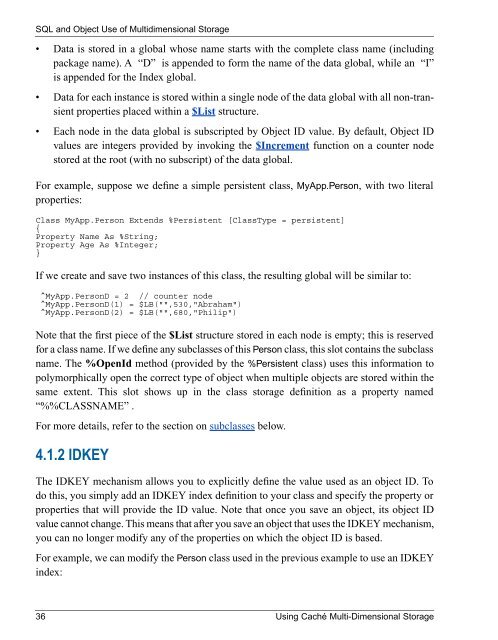Using Caché Multi-Dimensional Storage - InterSystems ...
Using Caché Multi-Dimensional Storage - InterSystems ...
Using Caché Multi-Dimensional Storage - InterSystems ...
You also want an ePaper? Increase the reach of your titles
YUMPU automatically turns print PDFs into web optimized ePapers that Google loves.
SQL and Object Use of <strong>Multi</strong>dimensional <strong>Storage</strong><br />
• Data is stored in a global whose name starts with the complete class name (including<br />
package name). A “D” is appended to form the name of the data global, while an “I”<br />
is appended for the Index global.<br />
• Data for each instance is stored within a single node of the data global with all non-transient<br />
properties placed within a $List structure.<br />
• Each node in the data global is subscripted by Object ID value. By default, Object ID<br />
values are integers provided by invoking the $Increment function on a counter node<br />
stored at the root (with no subscript) of the data global.<br />
For example, suppose we define a simple persistent class, MyApp.Person, with two literal<br />
properties:<br />
Class MyApp.Person Extends %Persistent [ClassType = persistent]<br />
{<br />
Property Name As %String;<br />
Property Age As %Integer;<br />
}<br />
If we create and save two instances of this class, the resulting global will be similar to:<br />
^MyApp.PersonD = 2 // counter node<br />
^MyApp.PersonD(1) = $LB("",530,"Abraham")<br />
^MyApp.PersonD(2) = $LB("",680,"Philip")<br />
Note that the first piece of the $List structure stored in each node is empty; this is reserved<br />
for a class name. If we define any subclasses of this Person class, this slot contains the subclass<br />
name. The %OpenId method (provided by the %Persistent class) uses this information to<br />
polymorphically open the correct type of object when multiple objects are stored within the<br />
same extent. This slot shows up in the class storage definition as a property named<br />
“%%CLASSNAME” .<br />
For more details, refer to the section on subclasses below.<br />
4.1.2 IDKEY<br />
The IDKEY mechanism allows you to explicitly define the value used as an object ID. To<br />
do this, you simply add an IDKEY index definition to your class and specify the property or<br />
properties that will provide the ID value. Note that once you save an object, its object ID<br />
value cannot change. This means that after you save an object that uses the IDKEY mechanism,<br />
you can no longer modify any of the properties on which the object ID is based.<br />
For example, we can modify the Person class used in the previous example to use an IDKEY<br />
index:<br />
36 <strong>Using</strong> <strong>Caché</strong> <strong>Multi</strong>-<strong>Dimensional</strong> <strong>Storage</strong>

















